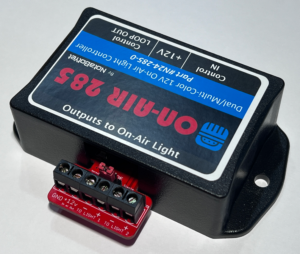
On-Air 285 from NotaBotYet
Some may ask, “Why did you call your product the On-Air 285?” The obvious answer is that “On-Air CCLXXXV” was simply not going to fit on the label! Roman numerals are better suited for clocks and large football games, not so good for on-air light controllers. Regardless of what we call it, its capabilities are rooted in the DNA of the current On-Air 85. When creating the On-Air 285 we started from the ground up with an all-new design, taking into consideration how best to control some of the new on-air lights out there.
The On-Air 285 is not a replacement for its predecessor the On-Air-85, but is actually a different product with different abilities. Both can control on-air lights but the choice of which to use is dependent on the needs and design of the facility. On-Air 285 has additional capabilities not found on the On-Air 85, including the ability to control dual-color on-air lights or two single-color lights individually. There is much more to this device than simply adding a “2” on the box! The “2” really stands for “twice the capability.”
Of course, the humble on-air light has been around long before radio professionals needed a way to politely inform everyone to remain quiet and avoid any behavior that might disrupt the broadcast (which we all agree would never happen in a modern radio studio, **wink**). Its history dates back to movie sound stages, where a red light, known as a “Wig-Wag,” was placed outside the door of a sound stage to signal that cameras were rolling. Back then, it was usually just a simple red lightbulb (please don’t start singing “Roxanne,” we know you want to!).
Today, that simple red lightbulb has been transformed by various manufacturers who now produce modern on-air indication products for studios in a variety of styles. Most of these are available in an LED version requiring only 12V power to illuminate. LED lighting provides manufacturers with numerous color options, including the ability to incorporate two colors in one light! However, we noticed that there was no dual-color on-air light controller on the market, and that is when we had our own lightbulb moment (the lightbulb associated with ideas, not the old red one outside the studio).
This bright idea was, “Why not develop an on-air light controller that can handle dual-color on-air lights?” And then we forgot all about it, worked on other projects, released some new products, worked on development of products that never saw the light of day, and eventually rediscovered the dual-color on-air light idea buried at the bottom of a bin. We thought, “Hey, what a great idea for a product!” and decided to bring it to life.

Here are the key features of the ON-AIR 285:
- Compatibility: The unit interfaces seamlessly with Axia GPIO, Wheatnet Logic, or any other open collector logic or dry relay closures to ground.
- Dual Control: It can independently control two lights or can manage a single dual-color device (such as the Titus Labs HPL or BPL series with a second color option).
- Flashing and Pulsing Programs: Beyond simple “ON” and “OFF,” the ON-AIR 285 offers various flashing and pulsing patterns. These patterns can be customized based on activations across its five input control lines.
- Customizable Scenarios: When integrated with Axia GPIO via Pathfinder or Wheatnet Logic using their scripting engine, users can program distinct flash patterns for different on-air scenarios. For example, a steady “ON” might indicate live microphones, while a triple strobe flash could signal live network broadcasting.
- Installer Options: The unit provides 31 pre-programmed “steady on” and flashing patterns for installers to choose from. Additionally, if needed, a “Simple” mode can be engaged by selecting a jumper and power-cycling the device.
Overall, the ON-AIR 285 streamlines control and enhances flexibility for managing on-air lights in broadcast environments.
 Inputs: The board accepts input via a standard RJ-45 connector. The pinouts of this connector match those on our NotaBotYet Axia GPIO Breakout Board (Part #A15-B01-2) or the RJ-45 connectors on any Wheatnet Logic port. If your facility doesn’t use Axia or Wheatnet, any relay or open collector device that triggers inputs by grounding can work with this board—just match the input pinouts. Additionally, manipulating the combination of the 5 available input control bits allows for up to 31 pre-programmed on-air flashing patterns or steady presets using one or both outputs.
Inputs: The board accepts input via a standard RJ-45 connector. The pinouts of this connector match those on our NotaBotYet Axia GPIO Breakout Board (Part #A15-B01-2) or the RJ-45 connectors on any Wheatnet Logic port. If your facility doesn’t use Axia or Wheatnet, any relay or open collector device that triggers inputs by grounding can work with this board—just match the input pinouts. Additionally, manipulating the combination of the 5 available input control bits allows for up to 31 pre-programmed on-air flashing patterns or steady presets using one or both outputs.
Outputs: The device’s outputs are accessible via a 6-position screw terminal strip, each labeled for its function.
Simple Mode for On-Air 285 Devices
Sometimes, the device controlling the On-Air 285 lacks the capability to manipulate the input control bits for different flash patterns. For instance, an Axia GPIO port without the use of Pathfinder can only switch one bit. In such cases, you can engage Simple Mode by moving the jumper located behind the output terminal.
Simple Mode is particularly useful when flash patterns, alternating colors, and other features are not needed. To switch back to “Normal Mode,” move the jumper back to the left (when reading the PCB text right side up) and perform a power cycle to properly enable the unit.
Instruction Sheet |
Part # N24-285-0 | ||
 |
 |
 |
|
 |
 |
 |
|
